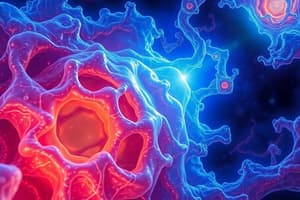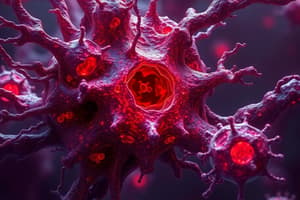Podcast
Questions and Answers
What is a constant feature of all forms of cell injury except Apoptosis?
What is a constant feature of all forms of cell injury except Apoptosis?
- Complete loss of DNA
- Rapid cell proliferation
- Loss of mitochondrial function
- Increased membrane permeability (correct)
What is the main consequence of damage to the plasma membrane?
What is the main consequence of damage to the plasma membrane?
- Osmotic balance loss (correct)
- Improved cell rigidity
- Enhanced cellular communication
- Increased ATP production
Which membrane alteration is typically associated with reversible cell injury?
Which membrane alteration is typically associated with reversible cell injury?
- Complete rupture of cell membrane
- Hydropic change or vacuolar degeneration (correct)
- Apoptotic body formation
- Increased extracellular matrix production
What triggers the initiation of Apoptosis in cells?
What triggers the initiation of Apoptosis in cells?
What is the consequence of lysosomal membrane damage?
What is the consequence of lysosomal membrane damage?
What are the major causes of ATP depletion?
What are the major causes of ATP depletion?
What is a consequence of mitochondrial damage?
What is a consequence of mitochondrial damage?
How does increased intracellular calcium influence cell health?
How does increased intracellular calcium influence cell health?
What defines oxidative stress?
What defines oxidative stress?
What is a free radical?
What is a free radical?
Which of the following is NOT a way to remove free radicals?
Which of the following is NOT a way to remove free radicals?
Which pathological effect is caused by free radicals?
Which pathological effect is caused by free radicals?
What triggers the generation of free radicals in neutrophils and macrophages?
What triggers the generation of free radicals in neutrophils and macrophages?
What is atrophy characterized by?
What is atrophy characterized by?
Which type of atrophy occurs during normal development?
Which type of atrophy occurs during normal development?
What mechanism primarily contributes to protein degradation in atrophy?
What mechanism primarily contributes to protein degradation in atrophy?
What type of metaplasia involves the replacement of ciliated columnar epithelium?
What type of metaplasia involves the replacement of ciliated columnar epithelium?
What can persistent factors causing metaplasia lead to?
What can persistent factors causing metaplasia lead to?
Which mechanism is involved in the cellular response to injurious stimuli?
Which mechanism is involved in the cellular response to injurious stimuli?
What can lead to irreversible cell injury?
What can lead to irreversible cell injury?
What is a key characteristic of metaplasia?
What is a key characteristic of metaplasia?
What is the standard environment that a cell looks to maintain for proper function?
What is the standard environment that a cell looks to maintain for proper function?
What type of cellular adaptation is characterized by an increase in cell size?
What type of cellular adaptation is characterized by an increase in cell size?
What is the primary cause that can lead to hypertrophy?
What is the primary cause that can lead to hypertrophy?
Which type of hyperplasia occurs in cells capable of dividing?
Which type of hyperplasia occurs in cells capable of dividing?
What type of hyperplasia is often hormonally induced?
What type of hyperplasia is often hormonally induced?
Which organ is commonly associated with pathological hypertrophy due to increased workload?
Which organ is commonly associated with pathological hypertrophy due to increased workload?
In which type of cellular adaptation does the structure change to a different differentiated cell type?
In which type of cellular adaptation does the structure change to a different differentiated cell type?
What results when both hypertrophy and hyperplasia occur in a tissue?
What results when both hypertrophy and hyperplasia occur in a tissue?
Study Notes
Atrophy
- Reduced size of cell, tissue, or organ due to loss of cell substance
- Two types: physiologic and pathologic
- Physiologic atrophy occurs during normal development, such as the involution of the gravid uterus.
- Pathologic atrophy can be caused by:
- Decreased workload (disuse atrophy)
- Loss of innervation (denervation atrophy)
- Diminished blood supply
- Inadequate nutrition
- Loss of endocrine stimulation (loss of estrogen)
- Mechanisms of atrophy:
- Decreased protein synthesis and increased protein degradation
- Degradation of cellular protein caused by the ubiquitin-proteasome pathway
- Increased autophagy
Metaplasia
- Reversible change in which one differentiated cell type is replaced by another cell type
- The new epithelium is better suited to dealing with the current stress or irritation
- Persistence of factors causing metaplasia may lead to progression into malignant transformation
- Most common epithelial metaplasia is columnar to squamous, often seen in the respiratory tract of smokers
- Mechanism: reprogramming of stem cells to differentiate along a new pathway.
Cell Injury
- Stress (if severe, prolonged or damaging) leads to injury
- Cell injury can be reversible or irreversible
- Irreversible cell injury results in cell death, which can be necrosis or apoptosis
Mechanisms of Cell Injury
- Depletion of ATP: caused by reduced oxygen and nutrient supply, mitochondrial damage, or toxins
- Mitochondrial damage: sensitive to hypoxia, chemical toxins, and radiation; can lead to necrosis or apoptosis
- Influx of calcium: increased intracellular calcium can induce apoptosis
- Accumulation of oxygen-derived free radicals (oxidative stress)
- Defects in membrane permeability: increased permeability leads to loss of osmotic balance, influx of fluids, and loss of cellular contents
- Damage to DNA and proteins: can trigger apoptosis if repair mechanisms fail
Cellular Responses and Adaptations to Stress
- Cells adapt to surrounding stimuli or changes to survive
- Cellular responses include adaptation, injury, intracellular accumulation, and calcification
- Adaptation: reversible changes in size, number, phenotype, metabolic activity, or function in response to changes in the environment
- Adaption can be physiologic or pathologic
Hypertrophy
- An increase in cell size resulting in an increase in the size of the organ
- Occurs in nondividing cells (cardiac myocytes, skeletal muscles)
- Can coexist with hyperplasia in dividing cells (skin, GI tract cells)
- Caused by increased functional demand (workload) or hormonal stimulation
- Mechanism: increased production of cellular structural proteins and organelles
- Example: left ventricle hypertrophy in the heart
Hyperplasia
- An increase in the number of cells resulting in an increased mass of the organ or tissue
- Takes place in cells capable of dividing
- Mechanism: growth factor-driven proliferation of mature cells, or increased output of new cells from tissue stem cells
- Types:
- Physiologic: hormonal (e.g., female breast during puberty and lactation) or compensatory (e.g., partial liver resection)
- Pathologic: excessive hormone stimulation (e.g., endometrial hyperplasia), or infections (e.g., skin warts)
- Pathologic hyperplasia can be a fertile soil for development of malignancy.
Studying That Suits You
Use AI to generate personalized quizzes and flashcards to suit your learning preferences.
Related Documents
Description
Explore the concepts of atrophy and metaplasia in this quiz. Learn about the mechanisms and causes behind these physiological changes, including the types of atrophy and their implications. Test your understanding of cellular adaptations and their significance in pathology.




